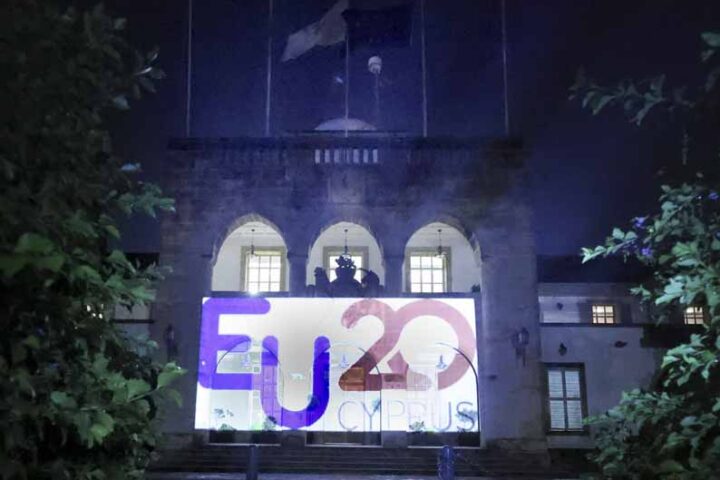.
By Matthew Stowell
In the cosmography of Cyprus wine, Chris Lambouris has been a late bloomer. Just as the grapes that stay longer on the vine before harvesting can become more concentrated in flavour and intensity, Chris was ripe and ready to produce something special when his moment finally arrived.
The fact that his family has been involved in wine for 300 years may have something to do with it. Long before there was an official wine industry in Cyprus — starting with the Haggipavlu and Chaplin families — the Lambouris were winemakers and wine merchants. Loading up donkeys with wineskins, they trudged two days down to Limassol to deliver wine and two days back. The giant oak that shades most of the new winery’s car park was planted by a Lambouris in the early 1700s.
 Chris was only ten years old when he enjoyed his first glass of Mavro and he has been slowly but earnestly advancing his wine education ever since. As a young man, he dutifully helped his father make his village wine, but upon matriculating from school Chris devoted 36 years of his working life to the Electricity Authority. Towards the end of that career, for three years he prepared himself by taking night classes in oenology. In 1989, working entirely on his own, he fermented his first grapes — Cabernet Sauvignon, Mavro and Grenache — in large plastic food barrels. Those invited to a tasting, including wine connoisseurs such as our own Patrick Skinner, told him he had the magic touch. He strove on, and two years later started building a small winery (see photo) that produced an improved version of his original dry red, plus a Rosé from Grenache and a dry white from Xinisteri.
Chris was only ten years old when he enjoyed his first glass of Mavro and he has been slowly but earnestly advancing his wine education ever since. As a young man, he dutifully helped his father make his village wine, but upon matriculating from school Chris devoted 36 years of his working life to the Electricity Authority. Towards the end of that career, for three years he prepared himself by taking night classes in oenology. In 1989, working entirely on his own, he fermented his first grapes — Cabernet Sauvignon, Mavro and Grenache — in large plastic food barrels. Those invited to a tasting, including wine connoisseurs such as our own Patrick Skinner, told him he had the magic touch. He strove on, and two years later started building a small winery (see photo) that produced an improved version of his original dry red, plus a Rosé from Grenache and a dry white from Xinisteri.
He had some vineyards of his own, as well as vines from other members of the family, and ever the frugal businessman he hired eager students for the picking and crushing. They had good clean fun, plus healthy exercise in the fresh alpine air, and Chris got his grapes in. Since those early days, the size of the vineyards has grown to 48 hectares, many of which are set on the northern slopes of Afames Mountain where they receive the benefit of less sun and brisk cooling breezes that help keep the moisture level down.
“In many wine-growing countries there isn’t enough sun. They have to trim away leaves to offer the fruit more exposure. But we’ve never had that problem in Cyprus. Just the opposite. That’s why we use a cup-shaped vine that protects the grapes from too much light. And we benefit from a higher, cooler altitude. We have some of the highest vineyards in Europe.”
Although he has winemaking in his blood, Chris has always relied on the oenologists at the Agricultural Ministry for theoretical as well as practical advice. All analysis is performed at government laboratories in Limassol.
When we talked, he had just been supervising the crushing of several truckloads of newly ripened grapes that had arrived still glistening with the morning’s mountain dew. “Each grape variety has its own harvesting time. They’re never the same. This is Xinisteri.”
I asked about an odd cluster of black grapes that he’d pulled away from the destemmer.
“Those are Maratheftiko. Sometimes they’re still growing in the middle of other grape varieties because they’ve been here a long time (a few thousand years!), yet it’s one of the most difficult to grow. It’s the first grape to blossom but the last to be picked. And the yield is very low.” He laughed, “That’s why it’s called Maratheftiko.”
Not knowing the long history of the region, I couldn’t follow.
“It’s named after the villagers of Marathassa, who somehow developed the reputation of being stingy people. And the Maratheftiko vine is a bit stingy with its grapes, which makes it more expensive. But good Maratheftiko grapes make a wine no other country can match.”
In 2001, Chris built an expansive showcase-style winery that includes two 10,000-litre horizontal fermenters (causing less damage to the wine), naturally cooled underground cavas, a tasting bar, business offices and a visitors’ center spacious enough to host seminars, corporate events, art exhibits and small weddings. It was also in 2001 that he sold the winery to a Russian company, but Chris remains the winemaker, chief spokesman and advocate. At present, he is making fourteen different wines, among them five organic wines: Pure Sweetness from Mavro and Grenache Noir; Pure Cabernet from 100% Cabernet Sauvignon; Pure Red from Grenache Noir, Mavro and Cabernet; Pure White from Xinisteri; and Pure Rosé (semi-sweet) from Grenache Noir and Mavro. The vines are inspected and closely monitored by the German organic farming regulator, Lacon. For the small but growing Jewish community in Cyprus and for export to Israel, Chris makes a Kosher red wine called Yain Kafrisin. All in all, Lambouri produces 85,000 to 95,000 bottles a year.
This season Chris will vinify Promara (white) grapes and will start planting the indigenous red Yiannouthi. He believes in and actively promotes the idea that Cypriot winemakers must concentrate more on what makes the island’s terroir unique. That includes cultivating the 17 grape varieties indigenous to Cyprus. Case in point, his favourite wine is his Maratheftiko (especially when accompanied by plates of barbecued wild boar or venison). He believes this native grape is the one that will promote Cypriot wine to a higher status on the map of world wines.
 It’s a convincing testament to Chris Lambouris’ skill as a winemaker that without the benefit of supermarket or wine shop sales (except for small retailers in his village of Kato Platres) he has managed to succeed. He exports some to Poland and Germany—Lufthansa features it in their airport lounges as well as inflight — and it graces the menus of the Londa and Columbia hotels. But the rest is sold either onsite to winery visitors or on the Internet (www.lambouri.com ).
It’s a convincing testament to Chris Lambouris’ skill as a winemaker that without the benefit of supermarket or wine shop sales (except for small retailers in his village of Kato Platres) he has managed to succeed. He exports some to Poland and Germany—Lufthansa features it in their airport lounges as well as inflight — and it graces the menus of the Londa and Columbia hotels. But the rest is sold either onsite to winery visitors or on the Internet (www.lambouri.com ).
It’s a lot easier than walking four days behind a donkey.
Matthew Stowell presenting the Cyprus Gourmet “Recommended Wine” Award to Chris Lambouris (www.cyprus-gourmet.com ).







